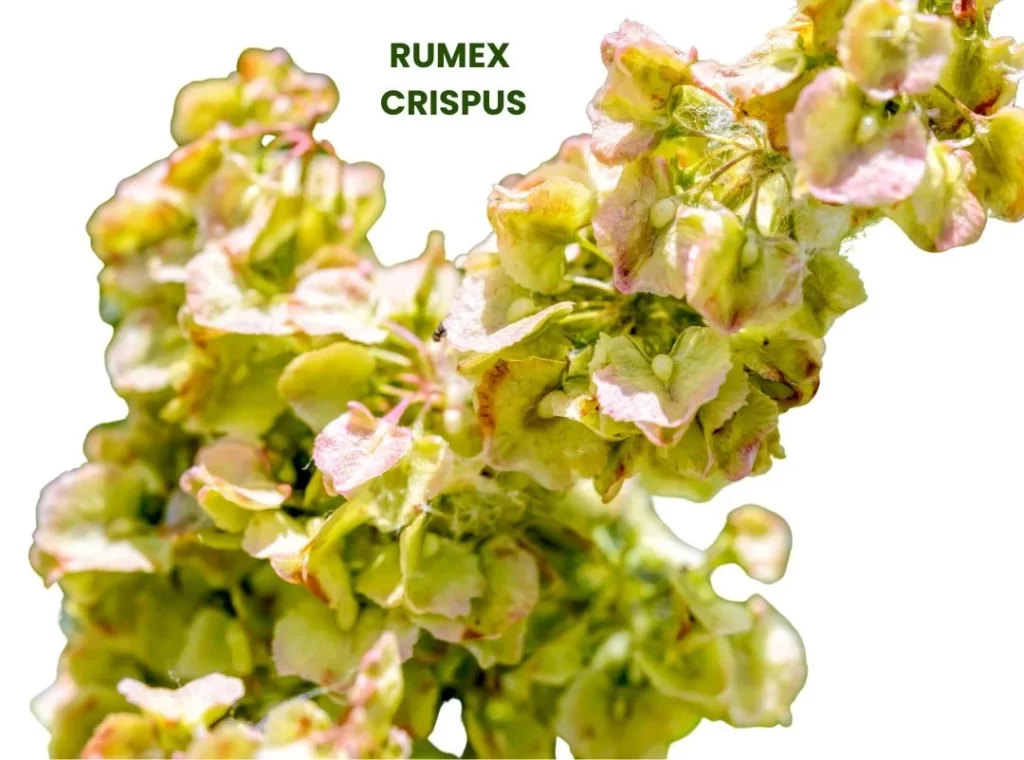Rumex Crispus, commonly known as Yellow Dock, is a homeopathic remedy renowned for its effectiveness in treating various respiratory and digestive symptoms, particularly those involving an incessant tickling cough and skin irritations.
The remedy is especially useful in cases where there is marked irritation of the mucous membrane.

SOURCE INFORMATION
Scientific Classification
- Kingdom: Plantae
- Clade: Angiosperms
- Clade: Eudicots
- Order: Caryophyllales
- Family: Polygonaceae
- Genus: Rumex
- Species: R. crispus
Origin
- Yellow Dock is native to Europe and Asia and has become widely distributed across North America.
- It has been used traditionally in herbal medicine for its digestive and detoxifying properties.
Historical Facts
- Yellow Dock has been utilized in traditional medicine for centuries, primarily as a remedy for digestive disorders and skin conditions.
- The plant’s roots were commonly used to treat liver and gallbladder issues, as well as skin irritations and constipation.
- It is known for its high content of anthraquinone glycosides, which contribute to its medicinal properties.
DRUG PATHOGENESIS
- Rumex Crispus primarily addresses symptoms related to an incessant, tickling cough and associated mucous membrane irritations.
- It is characterized by intense itching and irritation of the skin, as well as a dry, teasing cough that is exacerbated by exposure to cold air and pressure.
KEY CHARACTERISTICS
- Cough: Persistent and tickling cough, often triggered by touching the throat-pit and aggravated by cold air and motion.
- Skin Symptoms: Intense itching, particularly on the lower extremities, and urticaria (hives).
- Digestive Issues: Nausea, pyrosis (heartburn), and discomfort in the pit of the stomach.
- Respiratory Symptoms: Dry, teasing cough with copious mucous discharge; rawness and soreness in the respiratory tract.
DETAILED ORGAN SYMPTOMS
STOMACH
- Tongue: Sore edges, coated; sensation of a hard substance in the pit of the stomach.
- Digestive Discomfort: Hiccough, pyrosis, nausea; intolerance to meat which causes eructations and pruritus (itchiness).
- Jaundice: May follow excessive use of alcohol.
- Chronic Gastritis: Aching pain in the pit of the stomach extending to the chest and throat, worsened by motion or talking.
- Flatulence: General abdominal discomfort and pain, especially in the left breast area after meals.
RESPIRATORY
- Nose: Dryness with copious mucous discharge from the nose and trachea.
- Cough: Dry, teasing, and preventing sleep; aggravated by pressure, talking, cool air, and at night.
- Expectoration starts thin and watery, progressing too stringy and tough.
- Rawness: Rawness of the larynx and trachea, soreness behind the sternum (especially on the left side), and a lump sensation in the throat.
STOOL
- Diarrhea: Brown, watery stools in the early morning, often accompanied by a cough that drives the patient out of bed.
- Rectal Symptoms: Itching of the anus, with a sensation of a stick in the rectum; piles (hemorrhoids).
SKIN
- Itching: Intense itching, particularly of the lower extremities, worsened by exposure to cold air when undressing.
- Skin Conditions: Urticaria (hives), contagious prurigo.
MODALITIES
- Worse: In the evening, from inhaling cold air, pressure, talking, and uncovering.
- Better: Symptoms may improve with warmth and covering.
WHAT ARE MODALITIES IN HOMOEOPATHY?
RELATIONSHIP WITH OTHER DRUGS
Compare with,
- Causticum: For cough and mucous membrane irritation.
- Sulphur: For skin conditions and general irritability.
- Belladonna: For intense inflammation and throbbing pain.
- Rumex acetosa (Sheep Sorrel): For similar respiratory and digestive symptoms, used locally for specific conditions like epithelioma of the face.
- Rumex obtusifolius (Broad-leaf Dock): For nosebleed, headache, and other related conditions.
Antidote: Not specifically known; generally, symptoms are managed through avoiding known triggers and maintaining a comfortable environment.
Complementary: May be used alongside remedies for chronic cough and skin conditions as advised by a practitioner.
DOSE
- Potency: Third to sixth potency, adjusted according to individual symptoms and severity.
Frequently Asked Questions (FAQs)
What symptoms can Rumex Crispus treat?
- It is effective for persistent coughs triggered by throat irritation, intense skin itching, digestive issues, and respiratory discomfort.
How should Rumex Crispus be administered?
- Typically used in potencies ranging from third to sixth.
- Dosage should be personalized based on symptoms and their severity.
Are there any side effects of using Rumex Crispus?
- When used correctly, it is generally safe.
- Overuse may lead to mild aggravation of symptoms.
Can Rumex Crispus be used for children?
- Yes, but the dosage should be carefully adjusted according to the child’s age and symptoms.
What should be avoided while taking Rumex Crispus?
- Avoid exposure to cold air and triggers that exacerbate cough and skin irritation. Maintain a comfortable and warm environment.
Glossary of Difficult Words
- Pyrosis: Heartburn or a burning sensation in the chest.
- Urticaria: Hives; a skin condition characterized by itchy welts.
- Pruritus: Itching or an uncomfortable sensation on the skin.
This comprehensive overview of Rumex Crispus provides detailed information on its uses, symptoms, and administration, helping practitioners and patients manage relevant conditions effectively.
